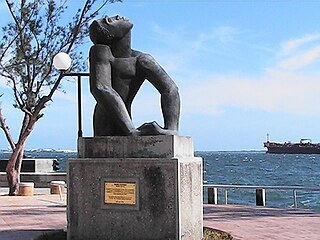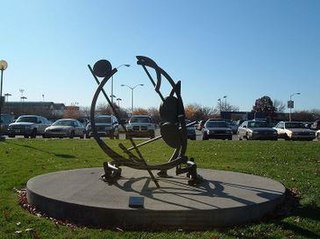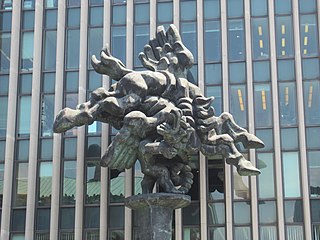Related Research Articles

Sir Jacob Epstein was an American-British sculptor who helped pioneer modern sculpture. He was born in the United States, and moved to Europe in 1902, becoming a British subject in 1910.

The University of the West Indies (UWI), originally University College of the West Indies, is a public university system established to serve the higher education needs of the residents of 18 English-speaking countries and territories in the Caribbean: Anguilla, Antigua and Barbuda, The Bahamas, Barbados, Belize, Bermuda, British Virgin Islands, Cayman Islands, Dominica, Grenada, Guyana, Jamaica, Montserrat, Saint Kitts and Nevis, Saint Lucia, Saint Vincent and the Grenadines, Trinidad and Tobago, and Turks and Caicos Islands. Each country is either a member of the Commonwealth of Nations or a British Overseas Territory.

The Chicago Picasso is an untitled monumental sculpture by Pablo Picasso in Daley Plaza in Chicago, Illinois. The 1967 installation of The Picasso, "precipitated an aesthetic shift in civic and urban planning, broadening the idea of public art beyond the commemorative."
Events from the year 1964 in art.

Edna Swithenbank Manley, OM is considered one of the most important artists and arts educators in Jamaica. She was known primarily as a sculptor although her oeuvre included significant drawings and paintings. Her work forms an important part of the National Gallery of Jamaica's permanent collection and can be viewed in other public institutions in Jamaica such as Bustamante Children's Hospital, the University of the West Indies, and the Kingston Parish Church.

Sir Alan Bowness CBE was a British art historian, art critic, and museum director. He was the director of the Tate Gallery between 1980 and 1988.

Henry Spencer Moore was an English artist. He is best known for his semi-abstract monumental bronze sculptures which are located around the world as public works of art. Moore also produced many drawings, including a series depicting Londoners sheltering from the Blitz during the Second World War, along with other graphic works on paper.

The Rio de Janeiro Botanical Garden or Jardim Botânico is located at the Jardim Botânico district in the South Zone of Rio de Janeiro.
Ronald Moody was a Jamaican-born sculptor, specialising in wood carvings. His work features in collections including the National Portrait Gallery and Tate Britain in London, as well as the National Gallery of Jamaica. He was the brother of anti-racist campaigner Harold Moody and award-winning physiologist Ludlow Moody.

The Lesser Antillean macaw or Guadeloupe macaw is a hypothetical extinct species of macaw that is thought to have been endemic to the Lesser Antillean island region of Guadeloupe. In spite of the absence of conserved specimens, many details about the Lesser Antillean macaw are known from several contemporary accounts, and the bird is the subject of some illustrations. Austin Hobart Clark described the species on the basis of these accounts in 1905. Due to the lack of physical remains, and the possibility that sightings were of macaws from the South American mainland, doubts have been raised about the existence of this species. A phalanx bone from the island of Marie-Galante confirmed the existence of a similar-sized macaw inhabiting the region prior to the arrival of humans and was correlated with the Lesser Antillean macaw in 2015. Later that year, historical sources distinguishing between the red macaws of Guadeloupe and the scarlet macaw of the mainland were identified, further supporting its validity.

Savacou: A Journal of the Caribbean Artists Movement was a journal of literature, new writing and ideas founded in 1970 as a small co-operative venture, led by Edward Kamau Brathwaite, on the Mona campus of the University of the West Indies, Jamaica.

Entangled, 2004, is an abstract sculpture created by Indiana-based artist Brose Partington. The sculpture is located on the Indiana University-Purdue University Indianapolis (IUPUI) campus at the Herron School of Art and Design, 735 W. New York Street in Indianapolis, Indiana, in the United States. It was given to Herron by Ezra Freidlander and Linda H. Freidlander in 2005.

The Letter Carriers' Monument is a piece of public art by American artist Elliot Offner, located on a triangular plot formed by North 2nd Street, North Plankinton Avenue and West Wells Street in downtown Milwaukee, Wisconsin, in the United States. Created in 1989, the monument depicts three letter carriers and was commissioned in celebration of the centennial of the National Association of Letter Carriers (NALC).

Agostino Brunias was an Italian painter who was primarily active in the West Indies. Born in Rome around 1730, Brunias spent his early career as a painter after graduating from the Accademia di San Luca. After he befriended prominent Scottish architect Robert Adam and accompanied him back to Britain, Brunias left for the British West Indies to continue his career in painting under the tutelage of Sir William Young. Although he was primarily commissioned to paint the various planter families and their plantations in the West Indies, he also painted several scenes featuring free people of colour and cultural life in the West Indies. Brunias spent most of his West Indian career on the island of Dominica, where he would die in 1796. Historians have made disparate assessments of Brunias's works; some praised his subversive depiction of West Indian culture, while others claimed it romanticised the harshness of plantation life. Haitian revolutionary Toussaint Louverture was a prominent admirer of his work.

Modern sculpture is generally considered to have begun with the work of Auguste Rodin, who is seen as the progenitor of modern sculpture. While Rodin did not set out to rebel against the past, he created a new way of building his works. He "dissolved the hard outline of contemporary Neo-Greek academicism, and thereby created a vital synthesis of opacity and transparency, volume and void". Along with a few other artists in the late 19th century who experimented with new artistic visions in sculpture like Edgar Degas and Paul Gauguin, Rodin invented a radical new approach in the creation of sculpture. Modern sculpture, along with all modern art, "arose as part of Western society's attempt to come to terms with the urban, industrial and secular society that emerged during the nineteenth century".

Bellerophon Taming Pegasus is an outdoor sculpture by Jacques Lipchitz, depicting Bellerophon and Pegasus. It was the final sculpture worked on by Lipchitz, and was completed after his death in 1973.
Christine Craig is a Jamaican writer living in Florida, United States. She has published collections of poetry and short stories, as well as children's fiction and several non-fiction works.

A bronze statue of Moses by Croatian artist Josip Turkalj installed at the main campus of the University of Notre Dame in South Bend, Indiana, just outside of the Hesburgh Library. Commissioned in 1962, the sculpture is owned by the University of Notre Dame.

Maurice Prosper Lambert RA was a British sculptor. He was the son of the artist George Washington Lambert and the older brother of the composer and author Constant Lambert.
Brick House is a 16-foot (4.9 m) tall bronze bust of a black woman by Simone Leigh, installed along New York City's High Line from 2019 to 2021. Another edition of the sculpture was acquired by the University of Pennsylvania and installed at the campus' main entrance in November 2020. This statue is the first sculpture in Simone Leigh’s Anatomy of Architecture series, which combines architectural forms from varied regions with elements of the human body.
References
- 1 2 Ronald Moody (1900–1984) Artist Biography, Tate.
- 1 2 3 "Brief article on ‘Savacou’ by Ronald Moody [1964–5]", Tate.
- 1 2 3 Subject file relating to sculpture, Savacou. Tate.
- ↑ "Letter from Ronald Moody to Professor A L Cochrane of the Epidemiological Research Unit (South Wales) 26 March 1964", Tate.
- ↑ "Letter from Ronald Moody to Dr Miall of the Epidemiological Research Unit (Jamaica) 18 May 1963" Archived 4 March 2016 at the Wayback Machine , Tate.
- 1 2 3 4 Savacou Maquette, African and Asian Visual Artists Archive.
- ↑ "Ronald Moody", Diaspora Artists.
- ↑ "Letter from Professor A L Cochrane of the Epidemiological Research Unit (South Wales) to Ronald Moody, 26 April 1963", Tate.
- ↑ "Letter from Ronald Moody to Professor A L Cochrane of the Epidemiological Research Unit (South Wales) 6 September 1964", Tate.
- ↑ Shared Visions: Celebrating the 50th Anniversary of the University of the West Indies, Central Bank of Trinidad and Tobago, Catalogue, p. 19, Canoe Press, University of the West Indies, 1997.
- ↑ Rendel Harris, Boanerges, Cambridge University Press, 1913, p. 24.
- ↑ "Ronald Moody (1900-1984)", Petrine Archer [.com].
- ↑ Eddie Chambers, Black Artists in British Art: A History from 1950 to the Present, I.B.Tauris, 2014 ( ISBN 9781780762715), p. 69.